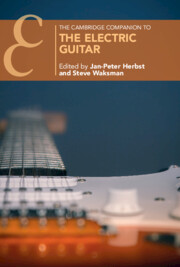Book contents
- The Cambridge Companion to the Electric Guitar
- Cambridge Companions to Music
- The Cambridge Companion to the Electric Guitar
- Copyright page
- Contents
- Figures
- Tables
- Contributors
- 1 Introduction
- Part I History
- Part II Technology and Timbre
- Part III Musical Style and Technique
- Personal Take III: Samantha Bennett
- 8 Technique vs Virtuosity in the Instrumental Gesture: From Classical to Rock and from Rock to Contemporary Creation
- 9 The Bass Guitar in Popular Music
- 10 Thumping, Glitch, and Butterfly Tapping: Innovations in Guitar Technique in the New Millennium
- 11 Rhythm Changes: Rhythm Guitar from Jazz to Funk
- Part IV The Electric Guitar in Society
- Part V The Global Instrument
- Index
- References
9 - The Bass Guitar in Popular Music
from Part III - Musical Style and Technique
Published online by Cambridge University Press: 08 November 2024
- The Cambridge Companion to the Electric Guitar
- Cambridge Companions to Music
- The Cambridge Companion to the Electric Guitar
- Copyright page
- Contents
- Figures
- Tables
- Contributors
- 1 Introduction
- Part I History
- Part II Technology and Timbre
- Part III Musical Style and Technique
- Personal Take III: Samantha Bennett
- 8 Technique vs Virtuosity in the Instrumental Gesture: From Classical to Rock and from Rock to Contemporary Creation
- 9 The Bass Guitar in Popular Music
- 10 Thumping, Glitch, and Butterfly Tapping: Innovations in Guitar Technique in the New Millennium
- 11 Rhythm Changes: Rhythm Guitar from Jazz to Funk
- Part IV The Electric Guitar in Society
- Part V The Global Instrument
- Index
- References
Summary
This chapter provide an overview of the ways that the bass guitar is most often used in popular music. Rather than discuss the instrument in terms of genre, I focus instead on its wider musical functions. As I argue, bass lines can largely be categorized by five common performative strategies: basic accompaniments, rhythmic- and groove-oriented approaches, melodic-oriented approaches, slap and pop styles, and the use of alternative instruments and techniques. While these strategies frequently overlap, this simplified taxonomy is intended to help listeners better appreciate how the bass shapes the overall sound and feel of a recording. By using a diverse cross-section of examples drawn from classic rock, metal, pop, R&B, soul, funk, reggae, disco, jazz, hip hop, and more, this chapter also highlights bass guitarists’ profound, wide-ranging impact on music history.
Keywords
- Type
- Chapter
- Information
- The Cambridge Companion to the Electric Guitar , pp. 150 - 164Publisher: Cambridge University PressPrint publication year: 2024

